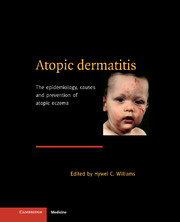Book contents
- Frontmatter
- Contents
- List of contributors
- Foreword Georg Rajka
- Preface
- Part I The nature of the problem
- Part II Descriptive studies which indicate the size of the problem
- Part III Analytical studies which point to causes of atopic dermatitis
- Part IV Intervention studies
- Part V Lessons from other fields of research
- 17 Parallels with the epidemiology of other allergic diseases
- 18 Recent developments in atopic dermatitis of companion animals
- Part VI Conclusions
- Additional information
- Index
- Plate section
17 - Parallels with the epidemiology of other allergic diseases
from Part V - Lessons from other fields of research
Published online by Cambridge University Press: 17 August 2009
- Frontmatter
- Contents
- List of contributors
- Foreword Georg Rajka
- Preface
- Part I The nature of the problem
- Part II Descriptive studies which indicate the size of the problem
- Part III Analytical studies which point to causes of atopic dermatitis
- Part IV Intervention studies
- Part V Lessons from other fields of research
- 17 Parallels with the epidemiology of other allergic diseases
- 18 Recent developments in atopic dermatitis of companion animals
- Part VI Conclusions
- Additional information
- Index
- Plate section
Summary
Introduction
For many years, atopic dermatitis (AD) has been the ‘poor relation’ in epidemiological studies of allergic diseases. In many ways this is puzzling, as the condition is more visible and amenable to objective assessment than asthma, rhinitis or food allergy and, arguably, it causes more misery than any of these. The epidemiology of asthma has received most attention, perhaps because it is occasionally a fatal disease, and accounts for a high proportion of paediatric hospital admissions.
This mass of epidemiological research has not been rewarded by clear advances in our understanding of what causes asthma. Instead, it has raised serious questions about the nature of the disease, the distinction between initiating and provoking factors, and the determinants of incidence and prognosis. These will be discussed and related to similar issues concerning AD.
In contrast, fewer studies have investigated the epidemiology of allergic rhinitis, but these have been more productive in generating novel hypotheses about environmental determinants of allergic sensitization. In general, the epidemiological features of hay fever parallel those of AD more closely than asthma, and may be particularly relevant to investigation of the causes of AD.
Finally, building on the themes introduced in Chapter 7, time trends in asthma, hay fever and AD will be reviewed together, with the aim of proposing a unifying hypothesis to explain the apparent rise in prevalence of all three atopic conditions worldwide in recent years.
- Type
- Chapter
- Information
- Atopic DermatitisThe Epidemiology, Causes and Prevention of Atopic Eczema, pp. 221 - 232Publisher: Cambridge University PressPrint publication year: 2000
- 4
- Cited by



